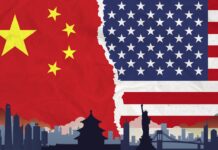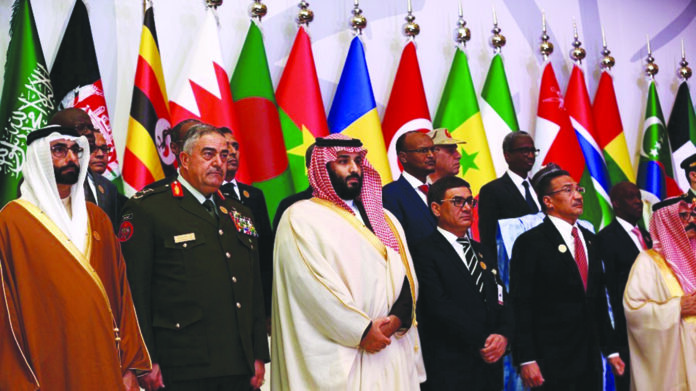The USA is attempting to revive its challenged position in the Middle East vis-à-vis Iran and its allies, Russia and China. The upcoming defense pact, known as the Strategic Alliance Agreement, will pave the way for an increased US role in determining the security dynamics of the region.
The establishment of the pact would depend on a renewed pledge by the USA to defend Saudi Arabia from external threats and a subsequent recognition of the Palestinian state which includes the Gaza Strip, the West Bank, and the East Jerusalem. In return, the USA is bidding for an eventual normalization of ties between the Arab States and Israel, and also Saudi permission to allow US forces to operate from within the Arab country’s soil. This latter part of the agreement may be tied to the US willingness and need to respond to regional challenges more swiftly and effectively especially in light of the Israeli occupation of Gaza and the challenges it faces from regional foes such as Hezbollah, the Houthis, and most importantly Iran.
The prospective agreement is considered a major U-turn by the Biden Administration in its policy towards Saudi Arabia. Beginning his term in 2020, Biden pledged to punish Saudi Arabia, especially for its role in the murder of Jamal Khashoggi in 2018. However, realist compulsions and its own challenged security position in the Middle East has apparently forced the USA government to revise its policy towards the oil-rich kingdom. The agreement will bolster Saudi defense in face of its perceived adversaries, Iran and its supported proxies in the region.
As an implication, Iran may also seek to bolster security ties with either Russia or China. A historical foreign policy analysis concludes that Russia may be more willing of the two to ink a similar deal with Iran. China’s rise as a global power is deeply connected to the idea of peaceful development and socio-economic cooperation. Currently, China is wary of inducing security apprehensions within regional countries, therefore a military alliance with Iran is highly unlikely. On the other hand, Russia and Iran have had strong military and political ties. Both countries’ foreign policies are characterized by a willingness for head-on confrontation with imperial powers of the West. In light of Iranian military support for Russia in the Ukraine War, a Russo-Iranian military pact has the potential to materialize in the near future as a counter to the Strategic Alliance Agreement.
In the deal, another major clause with potential destabilizing effect is the willingness on part of the USA to develop Saudi Arabia’s civilian nuclear programme. This may be taken as an affront by the Iranian government which has for decades fought a diplomatic battle with the Western powers for retaining its civilian nuclear capability but has only received increasing mistrust from the West in response. The policy circles within Iran, especially the revolutionaries, may interpret the civilian nuclear deal as a preliminary for subsequent development of a Saudi nuclear bomb, thereby heightening Iranian suspicion with the potential to prompt Iran to seriously consider nuclear weapons deployment.
Even though Iran and Saudi Arabia recently normalized diplomatic relations, nothing concrete has been done to bolster bilateral ties among the two regional contenders. Chinese efforts, although initially impressive, have been missing in the aftermath of the rapprochement creating a void which the USA is keen to fill. The normalization of ties with Israel as per the agreement, and increased US military presence and engagement may negatively impact the security calculus of the region by heightening an adversary’s threat perception, causing further crisis instability in the region.
These developments will only deteriorate the volatile dynamics in the Middle East, especially the highly contentious Saudi civilian nuclear programme. If the deal is formalized, it can potentially prompt Iran to attain similar security guarantees as well possibly from Russia. This paints a pessimistic outlook for the broader security of the Middle Eastern Region as complex alliances are notorious for lowering the threshold for conflict.
The greatest challenge for the deal right now is Israeli recognition of a Palestinian state which appears to be unlikely in the foreseeable future. Many security analysts argue that Israel has long had an aspiration for a Greater Israel. That said, the deal still faces challenges from the violence in Gaza which needs to be addressed. The UNSC resolution backed by the USA has as of yet failed to curtail the violence especially Israel’s continued massacre of ordinary Palestinians. Interestingly, President Biden put forward the ceasefire plan calling it an Israeli proposal, yet reports have emerged that far-right government officials within Israel’s coalition government have blatantly rejected it.
The ambiguous state of affairs may altogether jeopardize the US-Saudi pact. This brings us back to Iran’s role as a disruptive power in the region which has the capacity, through its network of proxies, to deny the conducive and secure atmosphere needed for such a deal to materialize. Experts already agree that the Hamas attacks on October 7 was, to some extent, prompted by Iran as it apprehended an Arab-Israeli normalization of ties and increased US role in providing security to the Gulf States, something Iran would never allow.
These developments will only deteriorate the volatile dynamics in the Middle East, especially the highly contentious Saudi civilian nuclear programme. If the deal is formalized, it can potentially prompt Iran to attain similar security guarantees as well possibly from Russia. This paints a pessimistic outlook for the broader security of the Middle Eastern Region as complex alliances are notorious for lowering the threshold for conflict.






















